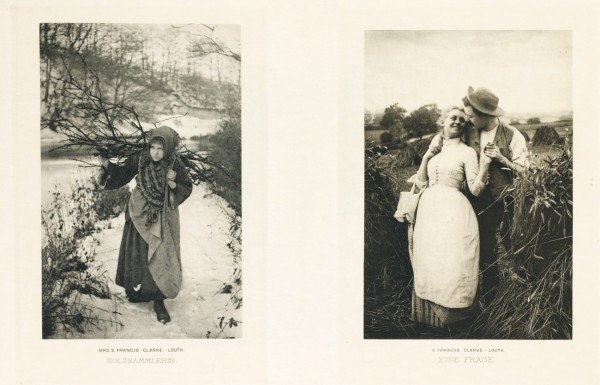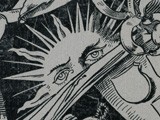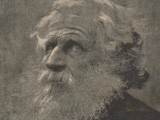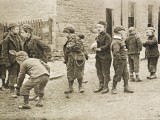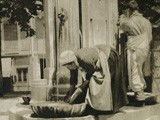Diptych: Holzfammlerin & Eine Frage
PhotographersMrs. S.F. Clarke, S.F. Clarke
CountryEngland
MediumPhotogravure
PortfolioAmateur-Kunst 1891 Vienna Exhibition
AtelierRichard Paulussen (Vienna)
Year1891
View Additional Information & Tags
Children, Diptych, Farming, Harvesting, Fields, Meadows, Genre: Children, Genre: Men, Genre: Women, Portrait: group, Portrait: Woman, Women: Occupational
Dimensions
Image Dimensions: Left: Mrs. Clarke: 17.0 x 10.7 cm --- Right: Mr. Clarke: 16.7 x 11.3 cm : Japan paper
Support Dimensions: 48.1 x 35.5 cm
The husband and wife amateur photographers Mrs. S. Francis Clarke and husband S. Francis Clarke were members of the Louth and District Photographic Society in England, where Mr. S. Francis Clarke served as Honorary club secretary.
Original comment on this plate from the Vienna Camera Club journal:
Blatt IV: „Holzsammlerin”, „Eine Frage” von Mrs. S. Francis Clarke in Louth. Von diesen Bildern ist unstreitig das erstere das bedeutend bessere. Ein junges, äusserst ärmlich gekleidetes Mädchen, noch ein Kind, kommt mit einer Last dürren Holzes einen beschneiten Berghang herab. Haltung und Miene sind natürlich, die Umgebung eine sehr passende, den Charakter der Dürftigkeit tragende. Das andere Bild stellt ein zwischen Aehrengarben hinschreitendes sich zärtlich umfangen haltendes Liebespärchen dar. Leider sieht das Mädchen, da es helle Kleider und eine grosse weisse Schürze trägt, zu wenig zierlich aus und drängt sich dem Blicke zu sehr auf.” 1.
In this diptych portfolio plate, it is interesting to note Mrs. Clarke portrayed her subject matter-a young female child-as performing a laborious task while her husband showed a more idealized portrayal of the feminine role-albeit grown up- in an outdoor setting. It would be interesting to discover if Mr. Clarke’s photograph was actually a self-portrait with Mrs. Clarke.
Three years after these photographs were shown in Vienna, Mrs. S. Fancis Clarke wrote about the subject of home portraiture in Anthony’s Photographic Bulletin:
“AT HOME” PORTRAITS.
BY MRS. S. FRANCIS CLARKE.
“Of all the varied fields offered by photography to its votaries, that of home portraiture seems most fitted to fall within the scope of women workers, for in this particular class of work they are saved the fatigue of carrying the photographic kit over longer or shorter distances, as most of the work must necessarily be done at or near home. I do not propose to touch at all the commercial aspect of women as photographers; that subject I must leave to those having professional experience. These notes are but an amateur’s advice to amateurs.
In home portraiture there is not any necessity to possess either a glass studio, a conservatory, or even a room that can be used for photographic purposes other than a darkroom. I do not, and probably never shall, care to possess one. For myself, I work entirely in the open air in a small backyard, surrounded on three sides by high, ivy-clad walls, offering for photographic purposes a workable area of something under 15 feet square.
In such a limited space, there is not much room for accessories. The fewer the better, I think, in portrait work. The necessary accessories consist chiefly of a couple of plain backgrounds, one gray, one dark brown, and a pair or two of curtains, with any chair or other piece of furniture the picture may suggest and the house provide. To control the top light, it is advantageous to stretch some muslin curtains upon cord overhead; they are easily drawn into place when required, and will be found to assist greatly in modifying the lighting, especially in large heads. A special background may occasionally—but only occasionally— be required. Then it must be either bought, borrowed, or, as I find sometimes necessary to do, painted by oneself for the occasion. Almost any good lens will do. Despite all that has been written to the contrary, I still use chiefly a R. R., and find it satisfy most of my requirements. As to the camera, the make of that is of no special importance, provided it is substantial and fixed upon a rigid stand.
Regarding draperies—and it is here that women workers should score so strongly over their male rivals in home portraiture—only cut lengths of suitable material should be used, tacking them together and draping them upon the sitter as the occasion and the subject of the picture require. On this overruling of the model’s own idea of how to dress “to be taken ” most of the ultimate success of the picture depends. If portraits are to be made, pictures that shall interest beyond the circle of the sitter’s own friends, all the draperies, the accessories and the pose must be shaped to that end. Chance may give an occasional success, but thorough and consistent results can only come from careful study of all the factors that enter into the picture and an unswerving determination not to pass anything which is short of the predetermined standard.
As a practical example, let us consider the taking of an old man’s head, in itself a commonplace, every-day subject enough. Yet what do we really require? If a likeness only is our aim, any old man’s head will do; if we desire a picture we must find a typical head, that shall declare itself as such without the aid of an elaborate explanatory title—a head that in the resulting photogram shall display a rugged intellectual strength of character, furrowed with the battle of life, bright with the hale heartiness of advancing years, suggestive of a story, and yielding to the beholder an intrinsic pleasure outside of the individuality of the portrait Such I set as the standard of Home Portraiture.
In conclusion, I would say, before starting a picture, know exactly what you desire the end to be. Having found your model, study it thoroughly; do not start until you have discovered the mood or expression best suited to the desired end. That knowledge gained, the work becomes a short, pleasant and almost easy road towards success. Remember always that any amateur wishing to take up this branch of photographic recreation must insist upon choosing her own subject for portraiture, with full liberty to robe and drape the figure as best suited to the picture, rejecting all those who would restrict this full liberty of choice, for if success is to be attained, the models must be like clay in the hands of the potter.—The Photogram.” 2.
1. Photographische Rundschau: Centralblatt fur Amateurphotographie: Edited by Charles Scolik: Volume IV: December, 1891: Published by Verlag Wilhelm Knapp: Halle a. S.: pp. 438-439
2.”AT HOME” PORTRAITS by MRS. S. FRANCIS CLARKE: in: Anthony’s Photographic Bulletin: New York: E. & H. T. Anthony & Co.: Volume XXV: February 1, 1894: pp. 69-71
